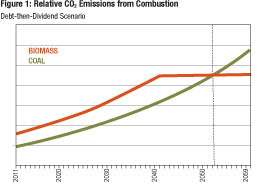
In 2010, the Manomet Center for Conservation Sciences conducted a study for the Commonwealth of Massachusetts to examine the greenhouse gas implications of using woody biomass for energy. Manomet’s report stated that burning wood initially emits more greenhouse gasses than burning fossil fuels, and that it can take 30 years or more for this “carbon debt” to be repaid. The news media misinterpreted the findings, screaming “Wood Worse than Coal” in headlines that played around the world. In response to the controversy, Manomet issued a statement of clarification, but stood by their science and the idea of a carbon debt. Massachusetts, for its part, took the study to heart and has drafted revised regulations that will dramatically reduce the likelihood of new biomass energy facilities being built under the state’s renewable energy portfolio standards.
The problem, as I see it, is that the debt-then-dividend axiom on which Manomet bases their whole study is fundamentally flawed. Those who study complex systems theory are familiar with the concept that selection is information; in this case, the Manomet authors have selectively limited the scope of their worldview in a way that only allows for one conclusion.
The foundation of the Manomet argument is that there is a debt when CO2 is released when we burn wood from a tree, and over a growth cycle, the debt is repaid as new trees grow and gather carbon from the atmosphere. Taken to the logical extreme, they’re taking a theoretical fully grown tree, harvesting it, burning it, measuring the carbon, then watching an empty space for 30 years until new trees grow in its place. Figure 1 shows this in a chart form.
But what if we look at the forest on a landscape level, rather than on a tree-by-tree basis? Say there’s a forest system with 1,000,000 tons of biomass on January 1 of a given year. Because forests are always growing, that system might have 1,010,000 tons of biomass at the end of that year. In this case, the forest has increased its carbon stock over the year by 10,000 tons. If 10,000 tons of biomass are harvested from the system on December 31, then the system begins the next year with the same stock of biomass and carbon it had at the beginning of the previous year. The harvest was carbon neutral.
Now instead of starting our carbon counter in the present, as Manomet does, let’s start it at the time the stand was last harvested. Figure 2 (below) takes a single stand of trees and starts the accounting 30 years ago, back in 1982. The dotted line is the zero net carbon level (this accounting doesn’t include any carbon other than that from combustion and it does not consider the carbon in the stumps and other unharvested components). The trees capture carbon for 30 years, which is shown by the downward sloping red line. In 2011, the forest is thinned, and the stand gives up the portion of its carbon accumulated in the last 30 years. The stand regrows over the next 30 years (it sequesters more carbon this time, due to improved silviculture).
Clearly this scenario has a number of simplifying assumptions that may change the shape and magnitude of the points on the chart. But the underlying conclusion is also clear: if biomass is harvested from existing forests that will be sustainably managed in the future, there is no debt. I call this “dividend-then-benefit” logic.
The Manomet authors have made it clear that their study’s scope was limited to Massachusetts. Since my background is in Maine’s wood supply, I’ll concede that it’s possible that Massachusetts cannot support any further growth in the use of wood for energy without depleting the stock of trees, though it’s worth noting that the U.S. Forest Service estimates that Massachusetts is presently harvesting only 25 percent of its annual growth. One should not assume that the Massachusetts conclusions can be extrapolated to other states. And none of that changes the Manomet study’s fallacy of not accounting for the already-accrued carbon dividend inherent in sustainably managed working forests, whether they are located in Massachusetts or elsewhere.
Manomet’s debt-then-dividend axiom is a flawed basis for a proper understanding of the carbon benefits that wood-to-energy can provide. In fact, Manomet gets it backwards. There is no debt if the forest system has been in growth-to-harvest equilibrium or has a growth-to-harvest ratio greater than 1/1 and the forest is managed sustainably so that the net stock of biomass does not deplete. By limiting its scope to only looking forward from 2011, Manomet ignored the “money in the bank” that’s been accruing for decades, which would be like ignoring the money you already have in the bank when deciding whether or not you can afford to take out a mortgage.
Wood-to-energy from sustainably managed forests, a process that all of Europe has codified in its carbon accounting rules, can provide net-zero carbon emission or even positive carbon sequestration if the woody biomass stock is not depleted or grows over time. A more detailed analysis of this subject can be found here.



Discussion *